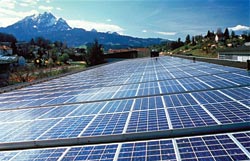Lowering the cost and increasing the performance of solar cells is the solar industry’s holy grail. Even in these turbulent economic times, research and innovation continue toward this end.
Kender Energy Inc. of Geneva is working on a method that combines the sun’s thermal and light energies to spin helium in a closed circuit. Currently in the development phase, its prototypes work by creating a heat exchange between the air and the sun. This starts helium gas spinning in a closed circuit, which rotates a turbine that produces electricity. At a speed of 120 rpm, the system produces 1390 W of power. The prototype has allowed a speed of 3000 rpm, which could produce 30,000 W.
According to Sean Kelly, president and CEO of Kender, the system produces the energy through what is essentially a Stirling engine: It uses no consumables or fuels to operate and can run in a variety of environmental conditions (from –100 to 210 °F).

Analysts and solar experts see the long-term viability of solar energy. Photo courtesy of BP Solar.
E.ON AG of Düsseldorf, Germany, has awarded a grant to the Advanced Technology Institute at the University of Surrey in the UK to study the incorporation of carbon nanotubes to increase the performance of organic-inorganic hybrid photovoltaic cells. The project, led by Ravi Silva, a professor and director of the institute, aims to improve organic materials-based solar cell technologies to reduce the cost.
Solterra Renewable Technologies Inc. of Tempe, Ariz., recently licensed quantum dot technology from Rice University of Houston to produce low-cost, thin-film quantum dot-based solar cells. An advantage to this approach is that the quantum dots’ tunable bandgap enables the wavelength at which they emit or absorb light to be adjusted. The quantum dots also are more flexible than traditional semiconductor materials: They can be applied to various materials, molded into forms or made into film.
Georgia Institute of Technology researchers in Atlanta are working on a chemical etching technique that replicates the superhydrophobic surface of the lotus leaf, which has surface roughness that allows water to run off, carrying dust or dirt with it. Through an etching process that uses nanometer-scale gold particles, the Georgia team has found, in principle, that the texturing increases light absorption as well as the cell’s self-cleaning ability.
According to C.P. Wong, a Regents professor in the School of Materials Science and Engineering at Georgia Tech, simulations show an increase in cell efficiency by as much as 2 percent.